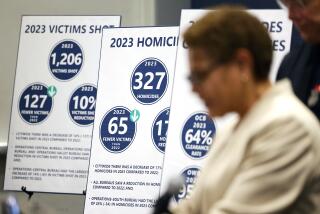Older Americans Less Likely to Be Victims of Violent Crime
- Share via
WASHINGTON — Contrary to popular conception, senior citizens in the United States fall victim to crime far less often than the rest of the population, according to a study released Sunday by the Justice Department.
In fact, when it comes to violent crime, the nation’s 31.3 million people 65 or older are 10 times less likely than those in younger age groups to be murdered, assaulted, robbed or victimized, the study found.
From 1992 to 1997, Americans 65 or older suffered just five violent crimes per 1,000 residents, versus 56 violent crimes per 1,000 people among those ages 12 to 64, the study found. People in nursing homes, accounting for about 4% of the senior citizen population, were not factored into the study.
Although senior citizens make up about 13% of the population, they constitute only 7% of crime victims, the study found. Purse-snatching, pickpocketing and other personal thefts were the only crimes affecting older Americans at about the same rate as the rest of the population.
“The risks are much lower [for senior citizens], but it may be because they’re living a different lifestyle that places them less at risk in the first place,” said Patsy A. Klaus, the Justice Department statistician who wrote the report.
“What we’re seeing is that the elderly are in their homes more often. They go out less often at night than other age groups, and when many do go out, for shopping and other necessities, it’s during the day” when they are less vulnerable to crime, she said in an interview.
The numbers, confirming similar patterns in the 1970s and 1980s, may surprise many senior citizens who believe that they are preyed upon by criminals much more often than younger people, said John Bordenet, who specializes in law enforcement issues for the AARP, formerly known as the American Assn. of Retired Persons.
Older people, he said, “are much more frightened of crime, especially violent crime, because they know they’re not going to mend as fast, they can’t escape as fast, they can’t fight back as well, and they know they can be pinpointed by the bad guys,” he said.
The reality, he said, suggests that, although elaborate alarms and home-security systems are still important, many older people would be better off refocusing their attention on protecting themselves from financial scams and fraud.
Phony sweepstakes and other financial scams aimed at older Americans have garnered widespread attention and spurred calls for increased safeguards in recent years. Although anecdotal evidence of such scams abounds, the Justice Department study, using police reports and surveys from the FBI and the U.S. Census Bureau, was not able to break down the rate of such “elder abuse” crimes.
But the study offered some troubling data on another type of abuse that has grabbed recent headlines--crimes against senior citizens by family and friends.
With an average of 1,000 senior citizens killed each year, the study found that the attacker was a “relative or intimate” in more than one in four cases--a rate twice that for younger people.
Gene Cohen, director of the Center on Aging, Health and Humanities at George Washington University, said that disturbing statistic deserves closer scrutiny.
“Is this a weather vane on the magnitude of violent elder abuse?” he asked. “That’s something we’d want to know more about, to find out exactly who these [attackers] really are.”
In all, older Americans were the victims of an average of 2.7 million property and violent crimes each year from 1992 to 1997. Those crimes include 2.5 million burglaries, car thefts and other property crimes; 46,000 purse snatchings or pocket-pickings; 166,000 rapes, robberies, assaults and other nonlethal violent crimes; and 1,000 murders.
More to Read
Sign up for Essential California
The most important California stories and recommendations in your inbox every morning.
You may occasionally receive promotional content from the Los Angeles Times.













